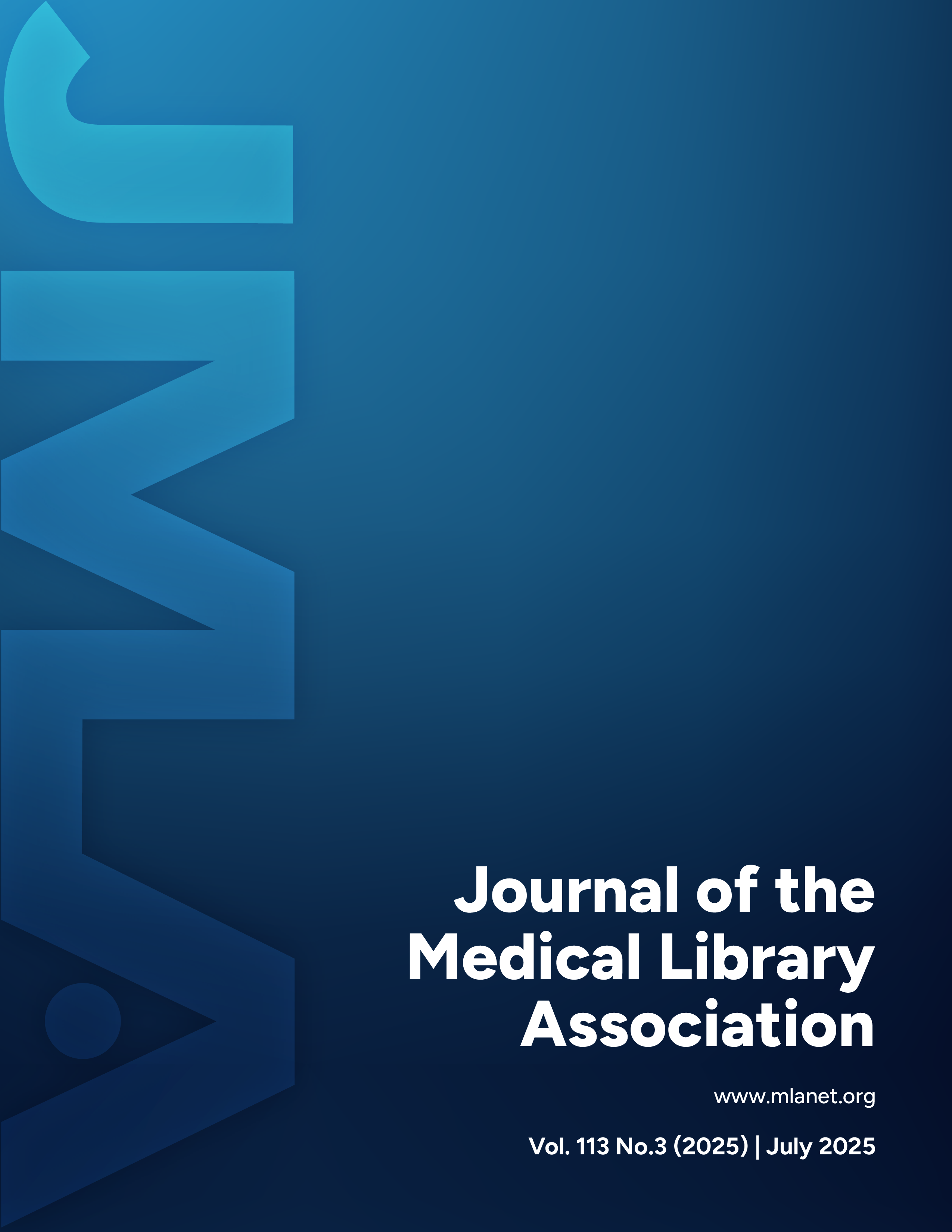Librarians collaborating with instructors for course integration of virtual reality
DOI:
https://doi.org/10.5195/jmla.2025.2090Keywords:
Libraries, Medical Education, Virtual Reality, Instruction, LibrariansAbstract
Background: Health science libraries have invested in virtual reality technology and spaces to support use of this technology for teaching, learning, and research. Virtual reality has many uses within health sciences education such as simulation, exploration and learning, and soft skills development. It can also be used to build empathy in health sciences students through applications that provide an immersive, first-person perspective.
Case presentation: This case describes how a health sciences library and liaison librarians partnered with a course instructor to support a class utilizing the library’s virtual reality resources. Librarians were collaborators in the development of the class and facilitated class sessions in the Virtual Reality Studio. Class sessions utilized the Beatriz Lab by Embodied Labs to increase empathy in medical students who were interested in working with geriatric or Alzheimer’s patients.
Conclusion: Liaison librarians support teaching and learning through a variety of tools and resources, including virtual reality. By partnering with instructors, librarians can use their instruction and collection knowledge to design and facilitate classes that are meaningful and interactive. Virtual reality applications provide another resource that librarians can incorporate into their course-integrated instruction sessions.
References
Johnson L. NMC horizon report: 2016 higher education edition [Internet]. Austin, TX: The New Media Consortium; 2016. [4 Feb 2016; cited 28 Feb 2025]. Available from: https://library.educause.edu/resources/2016/2/2016-horizon-report/.
Kolla S, Elgawly M, Gaughan JP, Goldman E. Medical student perception of a virtual reality training module for anatomy education. Med Sci Educ. 2020 Sep;30(3):1201–10. DOI: http://dx.doi.org/10.1007/s40670-020-00993-2
Mao RQ, Lan L, Kay J, Lohre R, Ayeni OR, Goel DP, Sa D. Immersive virtual reality for surgical training: A systematic review. J Surg Res. 2021 Dec;268:40–58. DOI: http://dx.doi.org/10.1016/j.jss.2021.06.045.
Dyer E, Swartzlander BJ, Gugliucci MR. Using virtual reality in medical education to teach empathy. J Med Libr Assoc. 2018 Oct;106(4):498–500. DOI: http://dx.doi.org/10.5195/jmla.2018.518.
Asad MM, Naz A, Churi P, Tahanzadeh MM. Virtual reality as pedagogical tool to enhance experiential learning: A systematic literature review. Educ Res Int. 2021 Nov;2021:1–17. DOI: https://doi.org/10.1155/2021/7061623.
Fister B. Librarians supporting the creation of new knowledge. In: New Roles for the Road Ahead: Essays Commissioned for ACRL’s 75th Anniversary [Internet]. Association of College and Research Libraries; 2014 [cited 2025 Feb 28]. Available from: https://acrl.ala.org/newroles/?page_id=263.
American Library Association. Virtual reality [Internet]. 2017 [cited 2025 Feb 28]. Available from: https://www.ala.org/future/trends/virtualreality.
Kouame G, Wood E, Orlosky J. A virtual reality library space for health centered education and well-being. J Hosp Librariansh. 2021;21(3):281–8. DOI: http://dx.doi.org/10.1080/15323269.2021.1944003.
Lessick S, Kraft M. Facing reality: The growth of virtual reality and health sciences libraries. J Med Libr Assoc. 2017 Oct;105(4):407–17. DOI: http://dx.doi.org/10.5195/jmla.2017.329.
Bard JT, Chung HK, Shaia JK, Wellman LL, Elzie CA. Increased medical student understanding of dementia through virtual embodiment. Gerontol Geriatr Educ. 2023 Jun;44(2):211–22. DOI: http://dx.doi.org/10.1080/02701960.2022.2067850.
Embodied Labs [Internet]. Available from: https://www.embodiedlabs.com/.
O’Connor ML, McFadden SH. Development and psychometric validation of the Dementia Attitudes Scale. Int J Alzheimers Dis. 2010;2010:1–10. DOI: http://dx.doi.org/10.4061/2010/454218.
Paul JC. An in-class exercise to promote empathy. JNEP. 2019 Jan;9(5):39. DOI: https://doi.org/10.5430/jnep.v9n5p39.
Huber A, Embree JK, Gay A, Gilman NV. Becoming immersed: Using Virtual Reality technologies in academic libraries to expand outreach and enhance course curricula. Coll Undergrad Libr. 2021;27(2–4):245–64. DOI: http://dx.doi.org/10.1080/10691316.2021.1902892.
Weyant EC, Carroll M, Walden RR. Lessons learned: Medical library pilot testing of a virtual reality anatomy lab. J Electron Resour Med Libr. 2021;18(1):20–34. DOI: http://dx.doi.org/10.1080/15424065.2021.1882920.
Kesselman MA, Watstein SB. Creating opportunities: Embedded librarians. J Libr Adm. 2009;49(4):383–400. DOI: http://dx.doi.org/10.1080/01930820902832538.
Polger MA, Okamoto K. “Can’t anyone be a teacher anyway?”: Student perceptions of academic librarians as teachers. Libr Philos Pract. 2010;1.
Fagan JC, Ostermiller H, Price E, Sapp L. Librarian, faculty, and student perceptions of academic librarians: Study introduction and literature review. New Rev Acad Libr. 2021;27(1):38–75. DOI: http://dx.doi.org/10.1080/13614533.2019.1691026.
Jameson J, Natal G, Napp J. Evolving and enduring patterns surrounding student usage and perceptions of academic library reference services. Coll Res Libr. 2019;80(3):366–85. DOI: http://dx.doi.org/10.5860/crl.80.3.366.
Downloads
Published
Issue
Section
License
Copyright (c) 2025 Ryn Gagen, Brooke Olson, Merete Christianson, Nicole Theis-Mahon

This work is licensed under a Creative Commons Attribution 4.0 International License.






